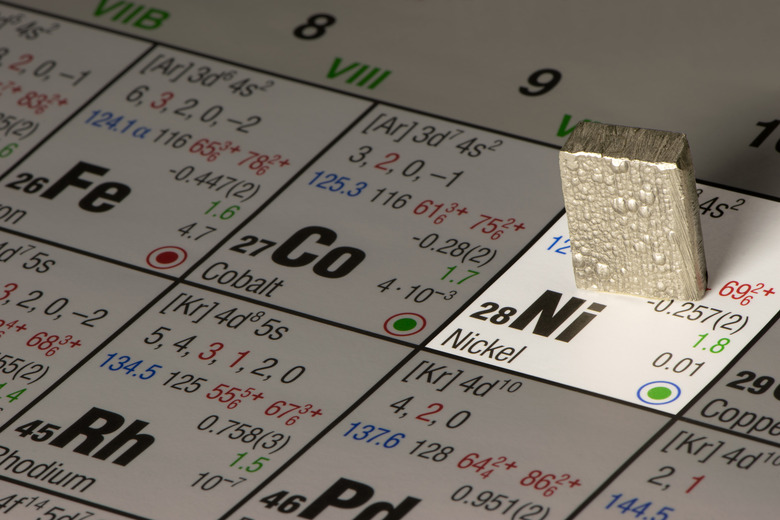How To Find The Number Of Orbitals In Each Energy Level
Energy levels and orbitals help describe the electronic structure of an atom. They designate how electrons are arranged within atoms, and the description of such energies is derived from quantum theory.
Quantum Theory
Quantum Theory
Quantum theory postulates that atoms can only exist in certain energy states. If an atom, or an electron by correlation, changes state, it absorbs or emits an amount of energy equal to the energy difference between the states.
The energy emitted or absorbed is quantized; it is energy characterized by definite amounts. These allowed energy states can be described by sets of numbers called quantum numbers.
Quantum Numbers
Quantum Numbers
An electron's arrangement in an atom can be described by four quantum numbers: n, l, m_l_ and ms. These relate to energy level, electron subshells, orbital direction and spin, respectively.
First Quantum Number: Energy Level
First Quantum Number: Energy
Level
The first quantum number is designated by n and is the principal energy level.
The principal energy level definition tells the observer the size of the orbital and determines energy. An increase in n is an increase in energy, and this also means the electron is farther away from the nucleus.
The first quantum number can only take integral values, beginning with 1; n = 1, 2, 3, 4 ... Each energy level corresponds to a letter as well: n = 1 (K), 2 (L), 3 (M), 4 (N) ...
First Quantum Number: Orbital and Electron Calculations
First Quantum Number: Orbital and Electron Calculations
To calculate the amount of orbitals from the principal quantum number, use **n2**. There are n2 orbitals for each energy level. For n **=** 1, there is 12 or one orbital. For n = 2, there are 22 or four orbitals. For n = 3 there are nine orbitals, for n = 4 there are 16 orbitals, for n = 5 there are 52 = 25 orbitals, and so on.
To calculate the maximum number of electrons in each energy level, the formula 2n2 can be used, where n is the principal energy level (first quantum number). For example, energy level 1, 2(1)2 calculates to two possible electrons that will fit into the first energy level.
Second Quantum Number: Electron Subshells
Second Quantum Number: Electron
Subshells
The second quantum number denotes sublevels and is designated by the letter l. This quantum number denotes electron subshells and the general shape of the electron cloud.
The first two quantum numbers are related. For any given n, l can take on any integral starting with 0 to a maximum of (n – 1); l = 0, 1, 2, 3 ...
The quantum levels, l = 0, 1, 2, 3 correspond to the electron subshells s, p, d, f, respectively. The shape of s is spherical, p is figure-eight shaped, and the d and f orbitals have a more intricate design, mostly involving clover-shaped orbitals.
Each electron subshell can contain a certain amount of electrons, s = 2, p = 6, d = 10 and f = 14.
Third Quantum Number: Orbital Direction
Third Quantum
Number: Orbital Direction
The third quantum number m_l_, denotes how the electron cloud is directed in space.
This quantum number can have any integral value, including 0, between l and –l (the second quantum number), or, m_l_ = l ... 2, 1, 0, -1, -2 ... -l
For l = 0, there is only 1 m_l value, also 0. This contains only one orbital. For a p orbital, ml_ = 1, 0, -1. This corresponds to the three p orbitals in three different directions, px, py, pz, corresponding to the three-dimensional x,y and z axis.
Fourth Quantum Number: Electron Spin
Fourth
Quantum Number: Electron Spin
The fourth quantum number designates clockwise or counterclockwise spin.
An electron is a charged particle spinning on an axis and therefore has magnetic properties. This quantum number is not related to n, l, ml, and can have only two possible values: +1/2 or -1/2.
The addition of the fourth quantum number allows electrons to fill into orbitals without breaking the Pauli exclusion principle. This states that no two electrons can have the same set of four quantum numbers.
Using Quantum Numbers to Calculate Orbitals
Using Quantum
Numbers to Calculate Orbitals
Recall that finding the amount of orbitals in an energy level can be derived by the formula n2. For the energy level 3, n = (3)2 or nine orbitals.
A more completed calculation can be made using the information from the quantum numbers above. For n = 3, the values of l can be added. For l = 0, there is only one orbital, _ml_ = 0. For l = 1, there are three values (_ml_ = −1, 0 or +1). For l = 2, there are five possible values (_ml_ = −2, −1, 0, +1 or +2). So adding the possibilities gives 1 + 3 + 5 = 9 orbitals in total.
Cite This Article
MLA
Kozlowski, Rosann. "How To Find The Number Of Orbitals In Each Energy Level" sciencing.com, https://www.sciencing.com/number-orbitals-energy-level-8241400/. 1 March 2020.
APA
Kozlowski, Rosann. (2020, March 1). How To Find The Number Of Orbitals In Each Energy Level. sciencing.com. Retrieved from https://www.sciencing.com/number-orbitals-energy-level-8241400/
Chicago
Kozlowski, Rosann. How To Find The Number Of Orbitals In Each Energy Level last modified August 30, 2022. https://www.sciencing.com/number-orbitals-energy-level-8241400/
